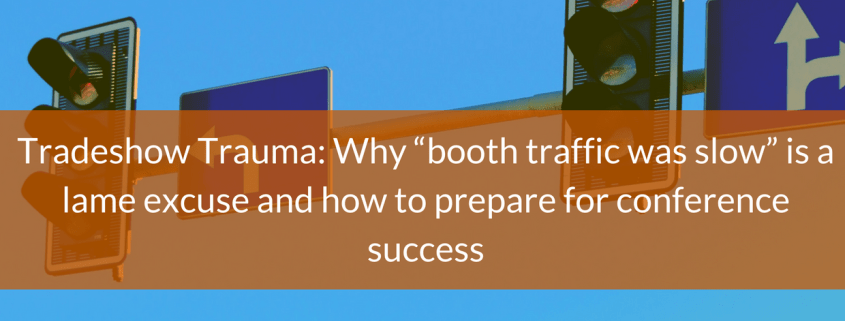As a marketing and PR professional who has spent countless hours in tradeshow booths and walked more than 20,000 steps at the HIMSS conference while wearing heels, I’ve experienced both the glory and the defeat of being an exhibitor. And while there is no better feeling than packing up your boxes, tearing down the booth and heading home after a job well done, there is also no greater pain than realizing that your company’s precious time and resources were virtually wasted because your conference strategy fell short.
After every tradeshow, it’s common to speak with exhibitors who complain that “booth traffic was slow” and cite that reason as the root of their conference failure. But let’s be honest — that’s a lame excuse. It’s the easy way out to blame poor performance at the show on exhibit hall organizers rather than reflecting on how your team may be at fault, or at least largely contributed to the problem.
In fact, upon much-needed reflection, those complainers would see that they are likely committing the cardinal sin of tradeshow marketing. They’re only focused on the conference. They’re not focused on the holistic strategy that enables the smartest, more successful companies to succeed at conferences again and again and again.
To avoid this tradeshow trauma and emerge triumphant in 2018, it’s critical for companies to have a three-pronged approach that includes not just a conference strategy where you show up and wait, but also and even more importantly a pre-conference strategy and a post-conference strategy.
Here are 4 insider secrets to help you get started:
#1 Never rely on booth traffic
Sure, booth traffic is nice and we all want it but it’s even better to drive traffic to your booth in advance. As savvy marketing professionals know, the best tradeshow marketing strategies start early and establish a regular cadence of communication. Most companies find that implementing a targeted email campaign starting 6 weeks in advance of the show is ideal but some may find that 8 weeks or 4 weeks works best for their audience.
These emails should be geared to both sales prospects to schedule meetings or demos and current clients to have a face-to-face touchpoint and determine cross-sale opportunities. As always, the top-performing emails are brief and targeted to attendees by role and job setting. It’s also best to have a form where attendees can schedule time and then receive a confirmation with a calendar invite. Why is that so important? It gets you on attendees calendars before they arrive at the show and are overwhelmed. Also, then your team can send them reminders about the scheduled slot or reach out if they don’t arrive as planned.
#2 Winning is great but winning isn’t everything
Pre-conference email campaigns can also invite attendees to activities in the booth such as speaking events or games instead of just meetings and demos. They can also offer attendees “a chance to win” and highlight big prizes, but they must not rely on the allure of a gimmick alone. There are few too many promotions for your giveaway to break through the noise. A pre-conference strategy that shares quality content, in addition to touting “a trip for 100 around the world” is the safest, most effective way to not only illustrate thought leadership but also to create brand awareness of your company as leader and innovator that offers far more than just a chance to win ““ but rather real ROI.
#3 Think like an attendee
Spoiler alert for those many hours spent in the booth. Nobody wants your marketing brochure! It will end up in the next trash can even if they take it, and if it makes it back to their room, it will end up in the hotel trash can. They also really don’t want a folder with multiple product one-pagers and a recent press release about your new product. Please note that this realization also spares your marketing team and admin hours of folder stuffing. Yes, you’re welcome.
The big idea here is to remember why attendees are at the conference. Most attendees are there to learn, not to purchase your “ground-breaking, best in class, fully integrated solution.” So, give them what they want like client case studies with real-world insights and thought leadership that demonstrates your knowledge and unique perspective. That’s the true value proposition that won’t get throw in the trash.
#4 Follow-up, follow-up, follow-up
It’s great to have a successful show, but it’s what companies do afterwards that matters most. It’s all about the follow-up communications, which should include a series of e-blasts, with the first prepared ahead of time and sent within 1-2 days of show close. The post-show e-blast should provide an opportunity to continue to engage with your company by downloading a new piece of content, registering for a webinar, or scheduling a full product demo for their broader team. However, the e-blast is not enough. To see results, it must be complimented by personalized follow-up from the sales team where there is even a small percentage chance of generating new pipeline. Without this timely and dedicated post-show communications, it’s impossible to reap the benefits of your hard work pre-show and at the show.
Remember, it doesn’t matter how many people attend the tradeshow. Only that the right people make it to your booth.
Instead of leaving success to chance, put together a three-prong plan that will tip the odds in your favor. It sure beats coming up with lame excuses later.
